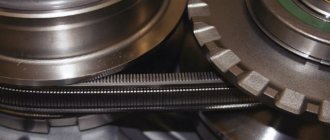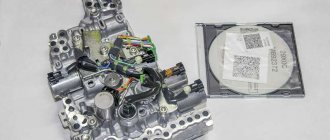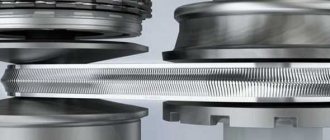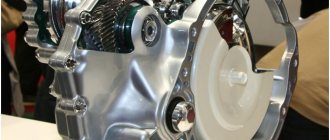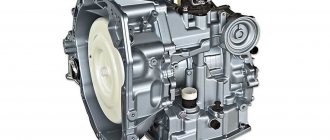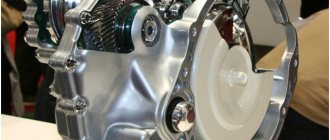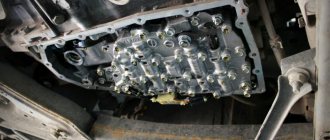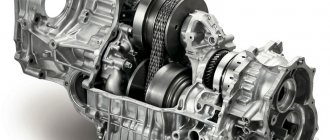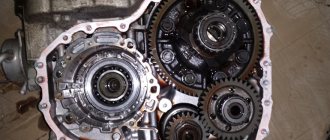In the cold season, not only the internal combustion engine and automatic transmission need to be warmed up, but also continuously variable transmission. Without warming up the box, the variator may fail ahead of schedule. Due to low temperatures, the elasticity of the belt and seals decreases, and the viscosity of the oil increases, which leads to increased load on the pump drive and an increase in pressure, due to which the sealing elements and valves of the valve body may be damaged.
As a result of deterioration in the working properties of the lubricant, torque also increases, and scuffing appears . To prevent premature wear and costly repairs to the gearbox, you need to know how to warm up a car with a CVT. Our article will tell you about this in detail.
Is it necessary to warm up the variator and why?
The transmission unit itself produces almost no heat during parking, so the variator is heated in cold weather mainly through the heat exchanger from the internal combustion engine. At the same time, due to hypothermia, negative phenomena occur inside the unit:
When the working fluid is cold, the end surfaces of the variator belt or chain wear out greatly, which significantly reduces its service life.
- the viscosity of the transmission oil increases, which causes its circulation to deteriorate and its lubricating properties to decrease;
- the oil pump, valve body, oil seals and other seals are overloaded due to the high density of the oil;
- the elasticity of rubber and polymer parts, such as belts, O-rings, oil seals, etc., decreases;
- gaps in the interfaces of moving elements, such as bearings and gears, increase, due to which shock loads increase, which is especially undesirable if there is a lack of lubrication (see above);
- the thickness of the oil wedge increases, causing the belt or chain to slip along the cone pulleys, causing scuffing;
- The maximum torque that the transmission is capable of transmitting decreases, which is why the dynamics and speed of the car drop, and fuel consumption increases.
It is necessary to warm up the variator in winter and summer, first of all, so that the working fluid reaches the required viscosity . The features of the processes occurring in a CVT transmission at different temperatures are described in detail below.
Design features
This type of transmission does not have gears of different diameters. Inside the box there are two pulleys that are connected by a belt or chain. With their help, the engine torque is transmitted to the wheels. The shape of the pulleys is V-shaped, so when their relative position changes, the radius of the rotating surfaces changes. Thanks to this, gear changes occur. This mechanism ensures the smoothest possible switching without jerks or jolts.
The gear shifting process is controlled electronically, and the clutch function is performed by a torque converter or discs located in the transmission fluid.
What happens to the variator in the cold
The operating temperature of the variator is in the range of +50…+100 °C (the exact norm values depend on the specific model). If you do not warm up the variator before driving, this will negatively affect its operation and lead to increased load on the components of the continuously variable transmission.
What happens to a car’s CVT at low temperatures is discussed in the table.
| Temperature, °C | What happens to the variator |
| -10 | The viscosity of the oil increases by an order of magnitude relative to normal values. The transmitted torque decreases, the load on the oil pump and valve body increases. The risk of chain/belt slippage remains even with light loads. |
| -20 | The oil is very viscous (two or more orders of magnitude higher than normal), the elasticity of rubber and polymer elements is much lower than normal, and the gaps in the friction pairs are outside the factory tolerances. Normal operation of the unit without warming up is impossible. If you load it sharply, slippage, scuffing, leaks and other malfunctions are almost guaranteed. |
| -30 | At temperatures of -30°C and below, even warming up is not able to completely eliminate the negative phenomena, since it becomes difficult for the transmission to return to normal temperature conditions. It is not recommended to operate a car with CVT unless absolutely necessary. |
To prevent premature wear of the transmission and its failure, it is necessary to ensure its smooth transition to normal temperature conditions. How to warm up a variator in cold weather and how long this process will take depends on weather conditions: the lower the ambient temperature, the more gentle the procedure should be and the more time it will take.
Not obvious, but important sensors
Correct operation of the CVT is ensured by a set of sensors. The main ones are oil level and pressure sensors. CVT problems are often associated with a failure of the speed sensor. This is accompanied by automatic transfer of the transmission belt to the middle emergency position, which leads to emergency braking of the power unit. This procedure is carried out by the electronic control unit. As a result of braking, especially if the speed sensor breaks down at high speeds, there is a high probability of deformation and even rupture of the belt.
Nissan speed sensor
All car enthusiasts purchasing a used Nissan car with a CVT are recommended to replace the speed sensor. In this case, it is better to buy original spare parts.
How long to warm up the variator
How long it will take for the variator to warm up optimally depends on the design features and external conditions. It is best to rely on the CVT temperature readings. You can start moving when this parameter reaches approximately +30 °C.
If the on-board computer cannot display the CVT oil temperature on the dashboard, you can use the ELM327 diagnostic adapter and diagnostic software for it, like Torque or OpenDiag. The CVT temperature parameter in this case is controlled via a smartphone, radio, tablet or other Android gadget.
How long does it take to warm up the variator: video
In the absence of the possibility of software control, you can indirectly determine how much to warm up the variator in winter using the ambient temperature. The colder it is outside, the longer it takes. Approximate time guidelines are indicated in the table below.
The most gentle warm-up mode for the variator is a combination of initial warm-up in the parking lot followed by a smooth warm-up while driving. Therefore, the values indicated in columns 3 and 4 of the table are not interchangeable alternatives (either/or), but complement each other. That is, it is advisable to fulfill both conditions!
How long does it take to warm up the variator: dependence of time on temperature
| Outdoor temperature, degrees Celsius | How long does it take for the variator to warm up? | |
| When parked | On the run | |
| +10 | Special warming up is not required. | It is recommended to avoid sudden acceleration and deceleration during the first 5 minutes of driving. |
| 0 | In the first 5-10 minutes of driving, avoid sudden accelerations, decelerations, slipping, and driving at high speeds (more than 2000-3000 rpm). | |
| -5 | About 5 minutes. It is enough to warm up the engine before driving. | |
| -10 | 5-10 minutes | 5-10 minutes |
| -20 | 10-15 minutes | 15-20 minutes |
| -30 | 20-30 minutes | 20-30 minutes It is recommended to take precautions throughout the trip. |
| -40 | Operating a car with CVT at temperatures below -30-40 °C is extremely undesirable. If there is no pre-heater or insulated garage (heated indoor parking), it is not recommended to leave. | |
How long to warm up the variator also depends on the car model and its transmission. On cars with heat-loaded engines (large-volume naturally aspirated gasoline engines) this happens faster than on low-speed and “cold” ones (high-volume diesel engines and turbo engines).
The most important thing for a variator is good oil
Oil for Nissan variator, there are also NS-3 and NS-1.
The main malfunctions of the Nissan variator appear due to poor control over the level and quality of the oil in the gearbox. The correct oil and its timely replacement will increase the period of trouble-free use of the CVT. Oil has properties that provide lubrication and prevent slipping of rubbing elements.
When changing the oil, it is better to use original lubricants that are approved by the manufacturer of the Nissan variator of a particular modification. The oil needs to be changed every sixty thousand kilometers.
How to properly warm up a variator in winter
CVT temperature in the diagnostic program for Android CVTz50
You can warm up the variator while parked and while driving. At temperatures from 0 to +10 °C, heating it in the parking lot is not necessary, but it is advisable. Proper warming up of the variator in cold weather includes both of these stages.
After all, if you heat it only in the parking lot, the process will be long, and when driving, the operating conditions of the CVT will be suboptimal, which will accelerate wear.
Instructions on how to properly warm up the variator in winter:
- Start the engine and let it run at idle. Refer to the time intervals indicated in the table above or the CVT temperature indicators - the minimum threshold is about +20 °C.
- On a car with a CVT connected via a torque converter (Renault, Nissan), switch the gearbox selector to mode D or R, with the parking brake (handbrake) on, and warm up in this mode. On a car where the torque is transmitted to the gearbox through a friction mechanism (automatic clutch), this manipulation may be meaningless.
- When the oil temperature in the variator reaches +20 °C or the approximate warm-up time indicated in the table has passed, you can start driving. You should move off smoothly, avoiding slipping, stalling, and revving the engine at more than 2 thousand rpm. If the parking lot and the road are snowy, and the selector is in position L (low mode), it is better to turn it on so that the torque is dosed more smoothly and the wheels do not slip. You need to start smoothly, avoiding sudden pressure on the pedal.
- After you start driving, you need to drive the first 10-15 km in a gentle mode, excluding the engine spinning up more than 2000 rpm, sudden acceleration and deceleration, and slipping. If the air temperature is below -25 °C, then these precautions should be observed throughout the entire trip, since the variator may not reach its optimal mode at all.
How to warm up the variator in position P (parking) correctly and for how long: video
Accelerated warm-up of the variator with the selector switched to position D (drive): video
In cold climate zones, where frosts below -10-15 °C are normal winter temperatures, you can additionally insulate the engine compartment. For this purpose, special fire-resistant blankets, radiator grille curtains and other similar devices are used. To speed up the warming up of the variator, you can insulate its oil cooler. But the gearbox housing should not be wrapped in insulating materials.
When insulating the gearbox oil cooler, you need to monitor its temperatures. It is important to keep them in their operating range, preventing overheating, and to remove the insulation in time when it gets warmer.
It is not recommended to change the variator oil in the winter for better warming up (if the regulated replacement period has not met), especially if we are talking about replacing it with a less viscous one. Firstly, the transmission resource is preserved only when using fluids regulated by manufacturer tolerances. Using the wrong oil can damage the unit. Secondly, a qualified replacement of the transmission fluid with a new one is carried out with the complete removal of remnants of the old one. If you mix two types of oil, the properties of the lubricating fluid may deteriorate and the service life of the gearbox may be reduced.
How to warm up a manual transmission in cold weather
The manual gearbox has been around since the time of the first car. Now it is not afraid of either severe frosts or sultry heat and is considered the most reliable gearbox of all. Oil is poured into it for extreme operating conditions; it is designed for the entire service life of the car. This oil thickens less in the cold than other types of gearboxes.
After starting the engine, manufacturers recommend not waiting for complete warm-up, but immediately hitting the road, without heavy throttling or drifting. As the temperature rises, the pace of movement can also be increased.
How not to warm up the variator
You cannot warm up the variator based on the recommendations for a classic torque converter automatic transmission. Despite the fact that the general principle of operation of the transmission, and especially if there is a valve body, is similar, some advice may turn out to be useless and even harmful.
What happens if you don’t warm up the variator: video
The main contraindications for continuously variable transmission include:
- sudden starts from a standstill;
- engine speed up to more than 3000 rpm;
- driving uphill with an unheated transmission;
- sudden engine braking;
- dynamic overtaking and lane changes;
- overcoming heavily snowy and icy areas.
It is also worth considering some common myths regarding continuously variable transmissions:
- Myth 1: the variator warms up while driving, so you can start driving right away . If you apply a load to the transmission when its oil has not yet reached operating temperature, the load on the unit will increase, and the risk of slipping increases significantly, which can lead to scuffing and breakdowns. You can start driving immediately after starting the internal combustion engine only at temperatures above 0 °C .
- Myth 2: the variator needs to be warmed up in all positions of the automatic transmission selector, like a classic automatic transmission . Switching the selector, as well as warming up in D or R mode, only makes sense for a CVT with a torque converter. On CVT models with friction connection (via the clutch), warming up cannot be accelerated in this way.
- Myth 3: in cold weather it is completely impossible to warm up the variator . Despite the slow rise in temperature, it is possible to warm up the variator even in cold weather. Unless at temperatures below -10 °C it is unlikely that it will be possible to achieve operating temperature values only by warming up at idle. It is almost impossible to warm up the variator only if the frost outside is below -30–40 °C .
- Myth 4: The variator does not need to be heated if an engine pre-heater is installed . The engine preheater eliminates the need to warm up the variator while parked if frosts do not drop below -10–15 °C. In this case, you can get underway immediately, observing the precautions outlined above. In severe frosts, you should not refuse to warm up the CVT, even with an engine heater .
- Myth 5: In winter, you can change the oil in the variator, after which you don’t have to warm it up . Replacing transmission fluid is possible only within the tolerances provided by the manufacturer. For example, for cold climates it is acceptable to change from Toyota CVT Fluid TC to CVT Fluid FE, but even when using a lubricant optimized for cold weather, warming up the variator is necessary .
Gentle operation of the variator is the key to its long-term operation. The estimated service life of such a transmission is 150–200 thousand km, which is quite realistic to achieve if you do not overload it and monitor its condition. If you handle it carelessly and ignore the recommendations outlined above, the CVT may not last even 100 thousand km, failing much earlier.
Is it necessary to warm up a car with an automatic transmission in the summer?
Considering that an automatic transmission is a complex device and also works thanks to oil (automatic transmission fluid ATF), the question of whether it is necessary
Whether
to warm up the automatic transmission in summer
, as in winter, disappears on its own. For normal and long-lasting operation of this unit, heating is simply necessary.
Interesting materials:
How to pay for Apple Music with a card? How to pay for a toll road with a card? How to pay for a Troika card with a bank card? How to pay for a commuter train with a Troika card? How to pay with a Mir card on the Internet? How to pay with a Qiwi virtual card in a store? How to leave a tip when paying by card? How to leave a tip when paying by card? How to format a memory card that cannot be formatted? How to format a memory card that the computer does not see?
FAQ
How to warm up the variator in summer?
At positive temperatures, specific heating of the variator is not required. It is enough to move off smoothly, avoiding sudden accelerations and slipping, and do not load the transmission for the first 5–10 minutes of driving. The optimal engine speed is about 2000 rpm.
How long does it take to warm up the variator?
How long the variator needs to be warmed up depends on the ambient temperature. It is recommended to start by letting it run at idle for 5 (near zero temperature) to 20–30 (frost below -20 °C) minutes, and then spend the same amount of time in motion without loading the engine and transmission.
How to drive a CVT in winter?
In winter, it is recommended to protect the variator from load changes, such as sudden acceleration and deceleration. It is better to overcome slippery and snowy areas slowly, in L mode, without sharply squeezing the gas pedal to prevent slipping. In frosts of the order of -30–40 °C and below, it is advisable to completely stop using the car if it is parked on the street or in an unheated garage.
Warm-up techniques
Warming up while moving
You can start the movement immediately without warming up. But it is important to follow certain rules. You need to start and brake smoothly, without accelerating at high speeds. Then the variator will warm up faster and more smoothly. Similar tactics can be used when leaving the yard. During the distance from the garage to the free street, the variator will have time to warm up. It’s also a plus for residents of settlements with rail and air crossings (there are some, but they’re rare. The most famous is Gibraltar. Author’s note). The main thing is to wedge into the flow at low speed just before closing or immediately after opening.
Features of operating the variator in different modes
To move forward in the vast majority of cases, mode “D” . The gear ratio is selected automatically and does not require any intervention from the driver. Many CVTs are equipped with additional modes for moving forward: sport, economical, winter. In appropriate situations, it is better to choose the most suitable modes.
Neutral gear is used when starting the engine. It is also recommended to turn it on when sitting in traffic jams for a long time, but this mode should not be turned on every time you stop for a short time.
Mode “ P” is used only when the vehicle is completely stopped. Moving the selector to this position prevents the vehicle from moving spontaneously. You should not forget about this when you park the car.
If necessary, you can use manual mode. The variator does not have any gears as such, but you can engage upshifts or downshifts.
Warming up the DSG gearbox (automatic robot)
This is the most complex and effective gearbox option among automatic transmissions. There are two types of such boxes: with dry and oil clutch. “Wet” clutches are installed on more powerful engines, since part of the energy is spent on overcoming the resistance of the oil bath. As a rule, this is DSG6, that is, a six-speed DSG. On lower power engines, DSG7 is used. Unlike the type of box, the heating will be different.
A gearbox with a dry clutch can be operated like a manual one: we start the engine, wait for the speed to drop, and then we can switch to “D” mode and hit the road. But it is better not to damage a dry clutch by standing on the brake for a long time, especially after a cold start. If after the start you get stuck in a traffic jam, then at first you need to move the selector to the “N” position to avoid rapid wear of the clutch discs.
A gearbox with an oil clutch needs to be warmed up longer, otherwise you will feel unpleasant jolts due to thickened oil. Such a clutch can be warmed up by briefly standing in “D” mode, but you should not be zealous, since an unheated robot cannot remain in this mode for a long time due to the lack of a torque converter.
Both boxes are not recommended for active driving immediately after starting to move.
